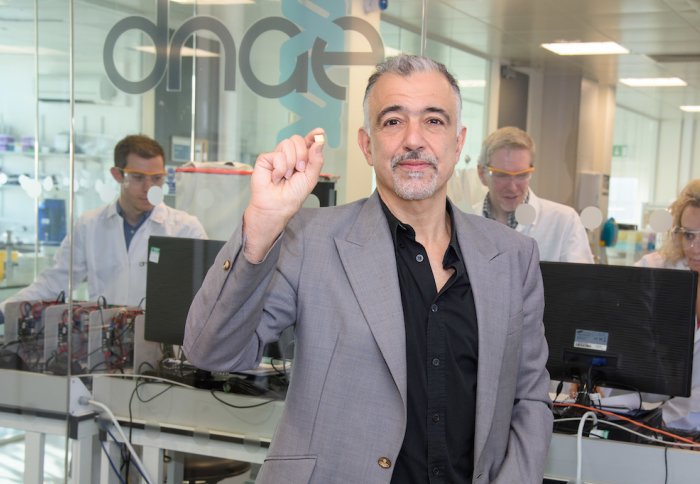
Professor Chris Toumazou holding the Genalysis silicon chip

A device that uses DNA analysis to quickly detect flu and drug-resistant bugs has attracted multi-million dollar funding from a US agency.
The device, known as Genalysis®, is being developed by start-up company DNA Electronics (DNAe), which was founded on research at Imperial. DNAe, which is based at Imperial's White City Campus, has been awarded a contract worth up to $51.9 million from the Biomedical Advanced Research and Development Authority (BARDA).
Our device would allow healthcare facilities to prioritize their limited supplies of antivirals and other healthcare resources, on the patients who need it most.
– Dr Sam Reed
Imperial alumnus and DNAe’s President, US Office.
The collaboration will see DNAe working with BARDA to further develop Genalysis®, so that hospitals in the US can rapidly detect the early signs of drug-resistant bugs and influenza in patients to make treatments quick, personalised and more effective.
Professor Chris Toumazou, Chairman of DNAe and Chief Scientist at Imperial’s Institute of Biomedical Engineering, said: “The way we diagnose patients is undergoing a massive transformation, similar to that which happened with computers. In the 1960s and 1970s, massive mainframe computers were the only devices able to crunch large amounts of data, but the digital revolution has seen the same computing power condensed into our phones. Similarly, we are now moving away from gene sequencing being carried out in big laboratories. Instead, devices like Genalysis will be able to do it more efficiently and quickly at the point of care, which we believe could lead to more effective treatments for patients.”
The Centers for Disease Control and Prevention (CDC) has estimated that more than two million people per year in the U.S. suffer antimicrobial resistant (AMR) infections, which results in 23,000 deaths. The CDC also predicts that a future flu pandemic could result in between 89,000 and 207,000 deaths in the U.S., which could cost the economy between $71.3 and $166.5 billion.
The gold standard laboratory analysis process for people with a suspected drug-resistant infection can currently take up to three days, making it much more difficult to treat patients. Genalysis® would analyse a patient’s blood sample and identify the bug and also sequence the genes that are resistant to treatments, in a matter of hours.
There are a number of clinical scenarios where this rapid analysis would be of benefit in the fight against antimicrobial resistance, says the team. For instance, in the case of staphylococcal infections, the device would determine the type of staph bacteria infecting the patient and determine if it was the kind that is resistant to the drug methicillin so that a combination of treatments can be administered.
In the case of influenza, the team believes Genalysis® could help to guide doctors on the use of antiviral medication. This type of medication must be rapidly administered in order to be effective. For the elderly, people with a weakened immune systems, and others with medical complications, a swift and accurate diagnosis and prescription can have a profound impact on their outcome. The Genalysis® team predict that their device will be able to determine the strain of influenza and antivirals needed to treat it.
Dr Sam Reed, an Imperial alumnus and DNAe’s President, US Office, said: “In 1918, the Spanish Flu pandemic is estimated to have killed 40-50 million people. If a new influenza pandemic arises, large numbers of symptomatic patients may arrive at healthcare facilities. The Genalysis® device could rapidly discriminate patients who have the newly-arising pandemic strain from those that have seasonal flu or other common viruses. Our device would allow healthcare facilities to prioritize their limited supplies of antivirals and other healthcare resources, on the patients who need it most. It would also give them the information they need to employ infection control measures that would limit the spread of the virus between patients.”
It can also be operated by users who are not specifically trained in genome sequencing, widening the range of healthcare professionals who can assess patients using this method.
The original brainwave for Genalysis® came to Professor Toumazou while carrying out research in the Department of Electrical and Electronic Engineering, and later at the Institute of Biomedical Engineering at Imperial. His son had lost his kidneys due to a genetic disorder, and Professor Toumazou became passionate about developing new tools for detecting and managing illnesses more effectively. He found a way to adapt semiconductors – the same technology behind mobile phones – for use in medical analysis. After years of research and development and the establishment of DNAe, the Genalysis® platform was born.
Getting Genalysis® into the heavily regulated US health market has always been a big goal of Professor Toumazou and DNAe. Professor Toumazou said the new system is already in the late stages of development and testing.
Article text (excluding photos or graphics) available under an Attribution-NonCommercial-ShareAlike Creative Commons license.
Photos and graphics subject to third party copyright used with permission or © Imperial College London.
Reporter
Colin Smith
Communications and Public Affairs

Contact details
Email: press.office@imperial.ac.uk
Show all stories by this author




Leave a comment
Your comment may be published, displaying your name as you provide it, unless you request otherwise. Your contact details will never be published.